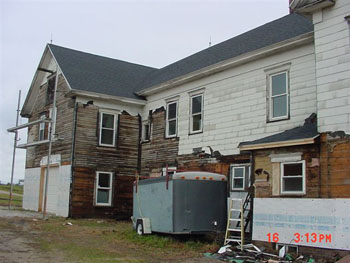Home → Waste Management → Programs → Asbestos → Asbestos Siding Removal
Asbestos Siding Removal
Asbestos-containing siding was a common building material in Maine during the middle part of this century. The exterior siding material is durable and cement-like and much less likely to release fibers than other asbestos-containing materials like pipe covering and boiler insulation.
Maine’s asbestos regulation allows a homeowner who is living in their single family home to remove their own siding following the removal procedures described below. You must hire a licensed asbestos abatement contractor if you want anyone else to remove your asbestos siding for you. The removal of asbestos siding from multi-family dwellings and commercial buildings must be done by a Maine-licensed asbestos abatement contractor. Generally, the removal of asbestos siding by an asbestos abatement contractor is not as costly as projects involving the removal of asbestos-containing thermal system insulation.
Removal of Asbestos-Containing Exterior Siding from Owner-occupied Single Family Residences
Work Practices
1. Set up a regulated area/exclusion zone with barrier tape or barricades. Do not allow unauthorized persons inside the area.
2. Place a drop cloth under the area in which you are working to collect any falling debris. After your job is complete, wet, roll-up, and double bag the drop cloth and dispose of it as asbestos waste
3. Wet the siding during the removal, and keep it wet at all times while working (be careful of electricity!)
4. Working from top to bottom, remove siding as whole as possible by pulling the nails out rather than breaking the siding. Please keep in mind that once asbestos siding is significantly broken, drilled or sawed, it becomes friable and must be handled by licensed professionals.
5. Double bag (6-mil plastic each) all debris for disposal. Use burlap bag as a third bag (inner) to prevent tears in plastic. An alternative wrapping method is to stack 6 to 10 pieces of whole siding on 2 layers of pre-cut 6-mil poly sheeting (sheeting is easier to obtain and less expensive than bags) and then securely sealing both layers with duct tape. The bagged (or wrapped) siding must be labeled as asbestos waste (labels are available at some hardware stores).
Protecting yourself
6. Homeowner should wear:
- Protective disposable suits (such as Tyvek), or coveralls that are handled and washed separately from other laundry;
- Respirators - half-faced (minimum), with purple (HEPA) filters (no beards); and
- Disposable gloves/booties are also recommended
7. Homeowner should shower immediately after finishing each work session. Wear the respirator into shower and remove only after completely wetting the body. Disposable suits and respirator filters should be disposed as asbestos waste.
8. Dispose of material either at a landfill licensed to accept asbestos waste (e.g., the Juniper RidgeLandfill 207-862-4200, or Waste Management Disposal Services in Norridgewock, ME 207-634-2714 and Rochester, NH 800-847-5303- call them first to see if they will accept your non-friable asbestos waste), or at a DEP-approved C&D landfill. Call your local landfill to see if they can accept your non-friable asbestos waste (transfer stations can not accept any asbestos materials). Alternatively, call a solid waste disposal company or an asbestos abatement contractor to pick up and dispose of your asbestos waste for you.
